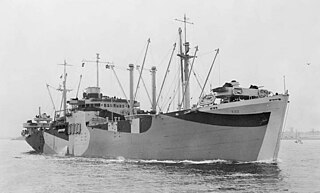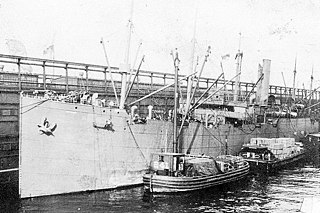
A landing ship, infantry (LSI) or infantry landing ship was one of a number of types of British Commonwealth vessels used to transport landing craft and troops engaged in amphibious warfare during the Second World War. LSIs were operated by the Royal Navy, British Merchant Navy, Royal Canadian Navy, Royal Indian Navy, and Royal Australian Navy. They transported British Commonwealth and other Allied troops in sea assaults and invasions throughout the war.

Type C1 was a designation for cargo ships built for the United States Maritime Commission before and during World War II. Total production was 493 ships built from 1940 to 1945. The first C1 types were the smallest of the three original Maritime Commission designs, meant for shorter routes where high speed and capacity were less important. Only a handful were delivered prior to Pearl Harbor. But many C1-A and C1-B ships were already in the works and were delivered during 1942. Many were converted to military purposes including troop transports during the war.

Empire Battleaxe was a British ship of the Second World War and as HMS Donovan in service with the Royal Navy just after the Second World War. Built as a Type C1-S-AY1 Landing Ship, Infantry named Cape Berkeley she then saw merchant service as Empire Battleaxe before being commissioned into the Royal Navy as HMS Empire Battleaxe and then Donovan. After she was decommissioned she returned to merchant service as Empire Battleaxe and was returned to the USA where she was renamed Cape Berkeley once again. A proposed sale in 1948 to China and renaming to Hai C fell through and she was scrapped in 1966.
The Cape class consists of two escort maintenance ships of the Royal Canadian Navy (RCN). The ships were built in Canada as Beachy Head-class maintenance ships for the Royal Navy, but were acquired by Canada in 1952. They were commissioned into the RCN in 1959 as HMCS Cape Breton and HMCS Cape Scott. Cape Scott served on the east coast until 1972, after which the ship became a stationary repair vessel at Halifax, Nova Scotia until 1975. The vessel was broken up in 1978. Cape Breton served initially as a school ship on the east coast before transferring to the west coast of Canada in 1959. The maintenance ship remained in service until 1964, when she was laid up at Esquimalt, British Columbia as a maintenance facility. Cape Breton remained in this service until 1993. The vessel was then sold for use as an artificial reef and sunk off the coast of British Columbia.

HMCS Cape Scott was a Cape-class maintenance ship. She was built for the Royal Navy as HMS Beachy Head in 1944. She was loaned to the Royal Netherlands Navy in 1947 as HNLMS Vulkaan and returned to the Royal Navy in 1950. She was sold to the Royal Canadian Navy in 1952 and served until 1975, used as an alongside repair depot after decommissioning.

HMS Greetham was one of 93 ships of the Ham class of inshore minesweepers. All ships in this class had names chosen from villages ending in -ham. The minesweeper was built by the firm of Herd & McKenzie in Buckie, Moray and was named after Greetham, Lincolnshire. Entering service in 1955, the vessel was transferred to the Libyan Navy in 1962 on loan and permanently in 1966. Renamed Zuara, the minesweeper was used as a patrol vessel until 1973. Zuara was sold to Captain Morgan Cruises of Malta for commercial use and renamed Lady Davinia. The ship was taken out of service in 2007 and laid up at Sliema Creek. Lady Davinia sank at her moorings in 2008 and for a short time became a diving attraction but in 2011 the wreck was partially broken up after being named a navigational hazard.
SS Empire Javelin was an Infantry Landing Ship or "LSI (Large)" in service with the UK in the latter part of the Second World War. Launched on 25 October 1943, she was a United States Maritime Commission C1-S-AY1 subtype, one of thirteen similar ships built by Consolidated Steel Corporation.

Empire Bittern was a steamship, built as a livestock-carrying cargo ship in 1902 at Belfast, Ireland as Iowa for the White Diamond Steamship Company Ltd of Liverpool. The ship was sold to the Hamburg America Line and renamed Bohemia in 1913.

HMS Cicero was an infantry landing ship in service with the Royal Navy during the late stages of the Second World War.
Two ships of the Royal Navy have borne the name HMS Rocksand:
Empire Broadsword was a Type C1-S-AY-1 infantry landing ship built in 1943 as Cape Marshall. She was renamed Empire Broadsword before completion and entering into service for the Ministry of War Transport (MoWT). She had a short career, entering service in December 1943 and being sunk by a mine in July 1944.
HMS Sansovino was an infantry landing ship in service with the Royal Navy during the late stages of the Second World War.
SS Empire Arthur was a 784-ton coastal tanker which was built in 1942. She saw service mainly in British coastal waters during the Second World War, and was briefly used as an auxiliary, supporting Royal Navy operations off western Africa. Her capsize in 1943 put an end to this, but she was salvaged post-war and returned to service for several companies, under the names Merula, and then Adherity, before being scrapped in 1962.

HMS LST 3519 was a Landing Ship, Tank of the Royal Navy, entering service during the last months of the Second World War. She was chartered for civilian service as the Empire Baltic from 1946, serving as an early RO-RO ferry until the navy suspended the charter and requisitioned the ship during the Suez Crisis in 1956. She briefly returned to normal service, but was retired soon after and was eventually sold for breaking up.
SS Empire Bunting was a 6,318 GRT cargo ship which was built in 1919. She saw service between the wars under the US flag and was transferred to the UK Ministry of War Transport in the Second World War. She made a number of cross-Atlantic voyages, often sailing in convoys. She ended her career by being sunk as a blockship on the Normandy coast, supporting the allied landings there in 1944.
Ravelston was an 2,808 GRT cargo ship which was built in 1906 for the Ravelston Steamship Co Ltd. She was requisitioned by the Ministry of War Transport (MoWT) in 1941 and renamed Empire Bond. In 1946 she was sold and renamed Prenton. Following a grounding in 1949, she was declared a constructive total loss, but was sold and repaired, returning to service as Agios Dionysissios. In 1951 she was renamed Sandenis and then San Denis, serving until she was scrapped in 1959.
Empire Cedric was the first ro-ro ferry. She was built for the Royal Navy as the Landing Ship, Tank, HMS LST 3534. She was commissioned in 1945 and converted for civilian use as a ferry in 1948. She was used in the Irish Sea on routes between Preston and Larne, and Preston and Belfast. In 1956, she was requisitioned by the Royal Navy for a few months during the Suez Crisis as HMS Empire Cedric. She served until 1960 when she was scrapped.

HMS Empire Spearhead was a Type C1-S-AY-1 Infantry Landing Ship (LSI) chartered by the British Ministry of War Transport (MoWT) during World War II. She was built by Consolidated Steel Corporation, Wilmington, California. She was launched as Cape Girardeau and completed as Empire Spearhead. In 1945, she was transferred to the Royal Navy and was later renamed HMS Ormonde. Later that year she was transferred back to the MoWT and renamed Empire Spearhead. In 1947, she was transferred to the United States Maritime Commission and renamed Cape Girardeau. The ship was laid up in 1950 and renamed Empire Spearhead. She was scrapped in 1966.

HMS Southern Prince was a motor ship that was built in 1929 as the refrigerated cargo ship Southern Prince. She was commissioned into the Royal Navy in 1940 as a minelayer. She became a headquarters ship and then an accommodation ship in 1944, was a fleet training ship in 1945, and returned to civilian trade in 1946. In 1947 she was sold to Italian owners who had her refitted as a passenger ship and renamed her Anna C. From 1952 she was a cruise ship. She was scrapped in 1972.










